Dalai Lama Imparts Wisdom to UCSB Crowd
His Holiness Graced the Thunderdome with Two Talks on Friday; Santa Barbara's Finest Turned Out
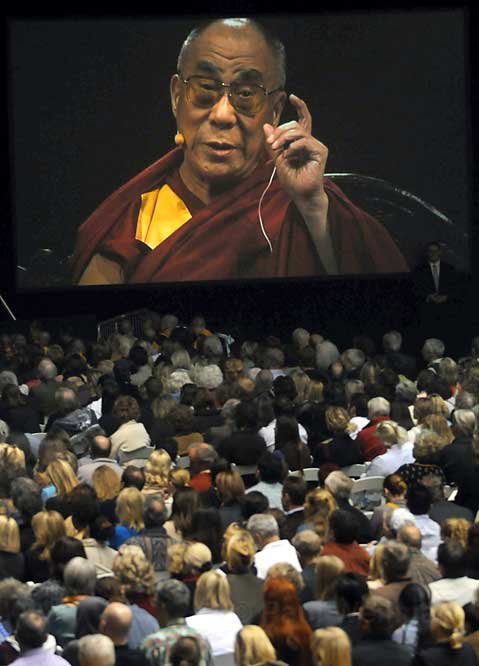
Perhaps the world’s most widely respected peacenik – and certainly one of the few who can bring together the rich, poor, old, and young of all countries and creeds – the Dalai Lama delivered two lectures to sold-out crowds at UCSB on Friday, leaving all in attendance with the message that the us-versus-them mentality is no longer relevant in the crowded 21st century, that our current economic crisis might actually be a good chance for learning about excess, and that the key to personal satisfaction is compassion and forgiveness.
Along the way, the presence of Tenzin Gyatso, the 74-year-old, jolly-faced man who is the 14th Dalai Lama, generated traffic jams, created eye-catching queues, stirred much buzz on campus and off, and attracted famous faces from Santa Barbara and beyond to the Thunderdome, where more than 5,000 people gathered for each of his speeches. When the talks – which both sold out in merely two hours many months ago – were said and done, there was more than $60,000 left over, which is now being sent to the Tibetan government to disperse as it sees fit.
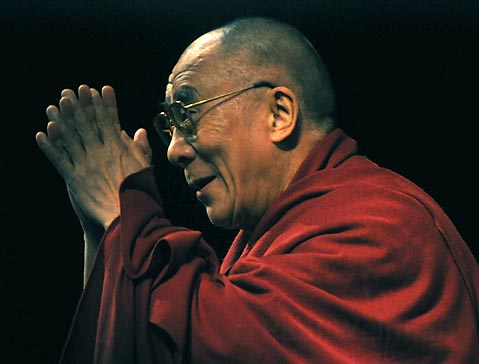
Though the energy level in Santa Barbara seemed to be rising all week, it got feverish on Friday morning, at least for those of us on the 8 o’clock 24X MTD bus from downtown to UCSB. Standing room only, the bus was filled with many lecture-goers, all discussing their various experiences and expressing excitement about the day ahead. By the time we reached Highway 217, the traffic was nearly backed up to Hollister Avenue, and it continued slowly through campus.
Protesters were supposedly going to appear and criticize the Dalai Lama for various perceived transgressions, but they weren’t visible, at least on the Thunderdome’s north side. Despite rumors of horrendous lines and needing to show up two hours in advance, the campus security detail handled everything quickly, and we were inside less than 20 minutes after reaching campus. Once in the Thunderdome, however, the bathroom lines were ridiculous – the women even took over the men’s bathroom at one point, but allowed men to enter freely so long as we used the urinals only.
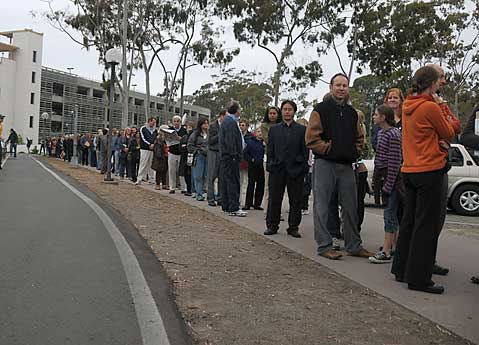
Assembled atop the floor where basketballs usually bounce were a mix of college students, senior citizens, and everyone in between, not to mention a few children too. At a casual glance, it was clear that the event was attracting Santa Barbara’s intelligentsia (Paul Orfaela, Nobel laureates, etc.) and religious leaders (Buddhist professor Alan Wallace, Chumash healer Adelina Alva Padilla, etc.) as well as the wealthy faces (too numerous to name) and top-of-the-line celebrities (Cher, in blue headband and leather outfit, and Goldie Hawn, who showed up late around 11 a.m.). And, of course, there were the multitudes of saffron-robed Buddhist monks seated at the front of the arena, snagging the best seats, all the better to see their Lama with.
Around 9:30 a.m., everyone rose and applauded as the Dalai Lama came onstage, flanked by Chancellor Henry Yang, UC Regent Chair Richard Blum, XIV Dalai Lama Professor Jose Cabez³n, and UCSB Humanities Dean David Marshall. Dressed in his standard deep red robe with saffron undergarments peeking out, the Dalai Lama prayed and bowed to the colorful Buddha image hanging behind the stage, gestured to the crowd, and assumed his cross-legged seat atop the yellow cushions on a carved wooden chair. As he did so, some in the crowd began genuflecting and bowing themselves in the traditional Tibetan manner.
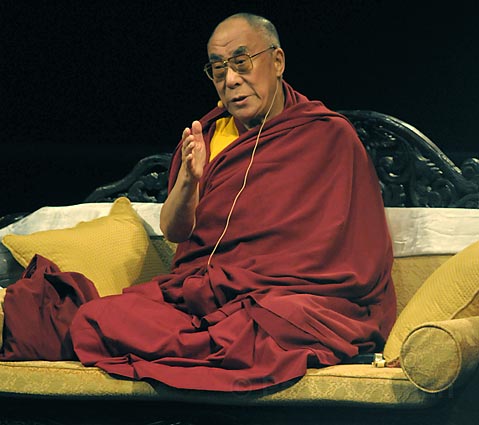
Yang’s opening speech explained that this was the fourth time the Dalai Lama had visited the campus and that the multiple visits result from UCSB’s world-renowned centers for Buddhist and Tibetan studies. He then introduced Blum, husband to Senator Dianne Feinstein, and the UC Regent chair discussed his long history with Tibet and explained that he’d been born within 10 days of the Dalai Lama. The difference between them, he explained, was that while we know the current Dalai Lama is the recincarnation of the 13th Dalai Lama, Blum had no idea who he had been before. “I must have been somebody bad to have come back as an investment banker,” joked Blum. (Both Yang and Blum’s speeches were later rehashed for the afternoon speech, though Blum took a stronger anti-China stance then.)
When it was finally time for the Dalai Lama, the cameras focused on the smiling man, who had a slightly red nose that he confirmed in sniffly tones resulted from a cold he’d recently caught. His morning speech was titled “The Nature of the Mind,” and he began discussing the various states of consciousness that we experience, from awake to sleeping to death. In death, he suggested, there may still be brain activity, and he cited some science that had been done to show as much. After about 30 minutes in English, the Dalai Lama switched to Tibetan, which was translated by his astonishingly able assistant, whose name was never uttered. The talk drifted into discussions of the primordial mind state and the distinction between a clean and an empty mind, and turned out to be a very technical treatise on Buddhism, replete with citations of various texts. Some people left the auditorium far before the talk was over, and some could even be seen reading the newspaper.
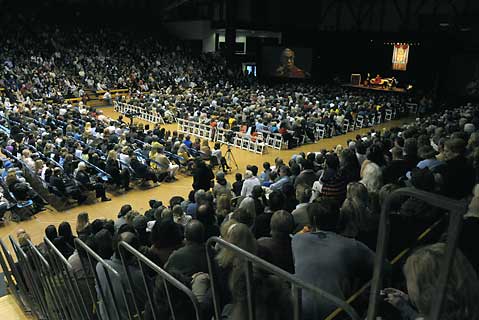
But everyone came alive when, after nearly two hours, it was question-and-answer time. Reading from emailed questions, the translator lobbed some at the Dalai Lama. He deflected quite a few, saying he would answer those in the afternoon speech, but did perk up when asked whether it was harder for Americans to live a more Buddhist life due to our fast-paced, stimulus-required lifestyles. While everyone expected an indictment of our way of life, the Dalai Lama explained that he thought a mind is a mind, and it doesn’t matter where you live or what you live like. “It’s same,” he said, giving hope to many in the audience who assumed our American pedigree put us on the wrong path from birth. Another interesting question was whether the Dalai Lama approved of the use of LSD and other psychedelics to achieve enlightenment. Though he admitted that he had never experienced the drugs, he did say that he’s heard they create more illusions. And in a world filled with illusions, he explained, why would you take drugs that only give more? He continued that serious practice does not involve external remedies, only the internal work.
During the break, those who were returning for the afternoon speech walked to Isla Vista or spots on campus for lunch. The recently built Student Resource Center was hosting numerous ethnic food booths just across from the Thunderdome, and I.V. was crawling with folks who didn’t seem to know where they were going and were happy to ask how your Javan’s sandwich tasted. (Good, by the way.)
After the break, the lines were longer than in the morning, stretching further than the eye could see. But once again, the lines moved fast once they got moving, despite having to stop at one point to let the Dalai Lama and his massive entourage – limos, Highway Patrol cars and cycles, armored Secret Service cars, etc. – through. And thanks to some warnings about bathroom lines in the afternoon, that wasn’t a problem either this time around.
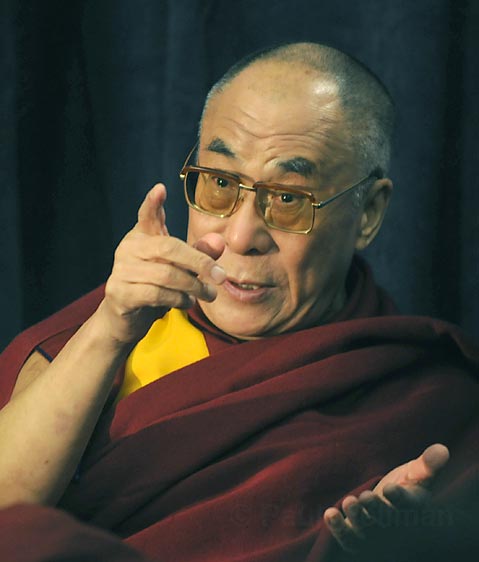
After a round of introductions, the afternoon speech turned out to be a much more accessible, understandable, and contemporary lecture, delivered all in English. The Dalai Lama used personal anecdotes to critique the problems he’s observing in the world, from classroom shootings and rising suicide rates to divorcing families and warring nations. He explained that he’s never found inner peace in material things, like his favorite wristwatch, nor does he find it in his dogs and cats or human friends. He said that it comes from within, in the form of compassion and forgiveness, the only gifts that each person can truly give away.
The Dalai Lama also took aim at exuberant lifestyles, explaining that maybe the current economic crisis is not such a bad thing after all. Perhaps it’s a chance, he said, for everyone to realize that the road of excess does not go on forever. He also preached the message of secularism, which he declared was not anti-religion, but rather the respect for all religions.
In discussing solutions, he said that it’s time for the younger generation to begin fixing families one-by-one, building stronger communities generation-by-generation. The Dalai Lama also cited a mother’s affection as the most powerful tool for ensuring physical and mental well-being, as well as compassion.
Toward the very end of his discussion, amid another great Q&A session, the Dalai Lama hit at China, saying that his little village in India, where he’s exiled, has set up a better democracy than the superpower. Though he said he respected Chairman Mao’s revolutionary dedication, he discussed the pains he felt getting his country taken away. But being exiled from Tibet, said the Dalai Lama, might have been his greatest blessing. “Sometimes I feel grateful to the Chinese Communists,” he said. “Ultimately, they created this opportunity.” And after a great day of wisdom from one of our planet’s holiest fellows, maybe more of us should be thanking China too.
(For more on that speech, stay tuned for another report on Independent.com tomorrow.)



